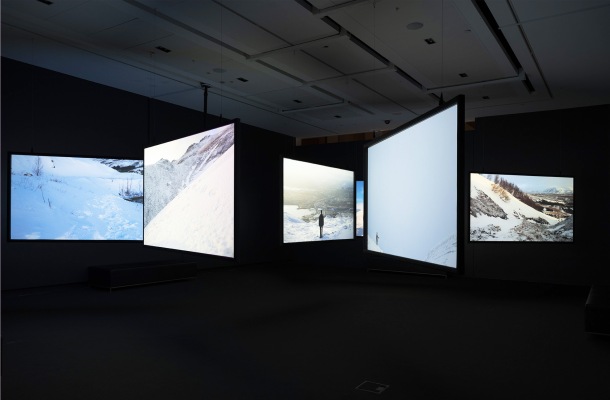
Known for his ambitious performances often undertaken in remote landscapes without an audience, Jacobus Capone uses his body to endure extreme conditions as a way of connecting to the environment. We caught up with the artist to find out more about his mesmerising seven-channel video installation currently showing at UQ Art Museum as part of the Unlearning exhibition.
Q: Can you tell us about the making of this work and why you chose Iceland as its location?
A: I had been to Iceland several times before undertaking this project, and it had always been during winter. I went for the first time when I was 18, following an uncanny sensation that it felt like home, more so than my country of birth. I was naïve enough to just wander out into the landscape with a tent and camp. That only lasted a couple of weeks until I became extremely ill.
Since then, each time I’ve been back I continue to spend long periods outdoors during winter, which in turn, has bred within me a deep reverence for the weather and landscape. This furthered my patience, perseverance, and commitment, and ultimately, led to me focusing more intently on my relationship to the country and questioning the intricate nature of it.
Embracing the indescribable inclination that made me journey there in the first place, I felt it necessary to pursue a project attempting to decipher it. Words seemed to fail; they seemed inadequate to honour and explore whatever was at play. Instead, spending prolonged periods of time in particular locations, either severe or serene, and being still and surrendering the body to the environment, made sense. Responding to such influences by direct and intuitive action ultimately became a means of experiencing the immediate environment in a more wholesome manner, devoid of intellectually filtering one’s experience.
These brief encounters in the moment somehow became enough, they reconciled my relationship there – to give time to a situation, circumstance and be in silence with it, to part ways not wanting more from it, but being thankful for the shared moment that was.
I filmed and documented the project over two years – during three-month periods in 2014 and 2015. The working methodology only really solidified after a residency in Reykjavik in 2014. At that point, I had only documented a couple of scenes – on a break wall and laying on a frozen lake. I saw the potential of these being the entry point to a large-scale project that might decipher what I discussed earlier.
Predominately working independently (although my partner helped with three scenes), I would set up the camera on a tripod framing the setting I felt drawn to. Days’ worth of recording would unfold. Reviewing footage would only happen at night, embracing what worked within the larger context of the project both aesthetically and conceptually. It was an intuitive and cathartic process, building up a bank of footage to eventually edit. I had chosen a specific number of locations to work with, as the project needed one solid parameter.
These sites were intended to become the central protagonist in the work, therefore getting a sense of each one’s presence was integral. I remember what I consider to be that last scene unfolding, where I applied silver paint across my face and shoulders. The temperature dropped dramatically and it began to snow. I had headed out to the location with the paint not knowing what would unfold. It all happened within a matter of an hour, and after I stopped recording I knew that it concluded the project and quelled my initial desire to search. Romantically, there was this hope that the silver paint would almost be the same tone as the sky and how I wished to just disappear within it.
Q: You made this work around four years ago. When you reflect on this piece now, how does it make you feel?
A: It was a breakthrough in terms of refining the performative side of my practice but more importantly opening it up to a larger audience. Before this piece, I wasn’t concerned about the quality of documentation of performance work. To this end, they were one-ended works that existed as images and stories, which in hindsight feels too didactic and selfish. The performances and interactions themselves were paramount. Dark Learning made me embrace the two completely different realities of working site-specifically and exhibiting such work, and as such, made me greater value how the audience could approach and experience it.
It made me realise that the intricate and sincere relationship that unfolds in the specific location in isolation can never truly be translated – and how this is one element of the project. The documentation, the weaving of it into a narrative, and how it’s exhibited is the other element. Both are very different, and consequently, could be viewed as two separate works.
Q: What do you hope viewers will experience or think about when they spend some time with this work at UQ Art Museum as part of our Unlearning program?
A: I could only hope that anyone who spends time with the work is suspended in the particular moment they have with it, not thinking, but rather being with it.
Dark Learning is showing at UQ Art Museum until 18 January 2020.



